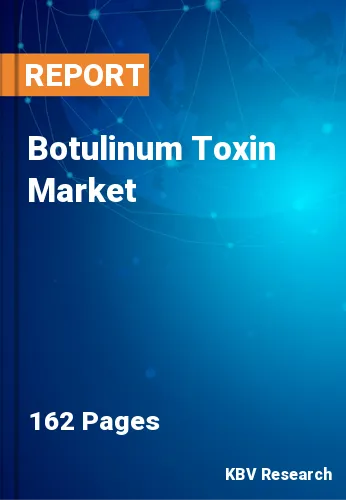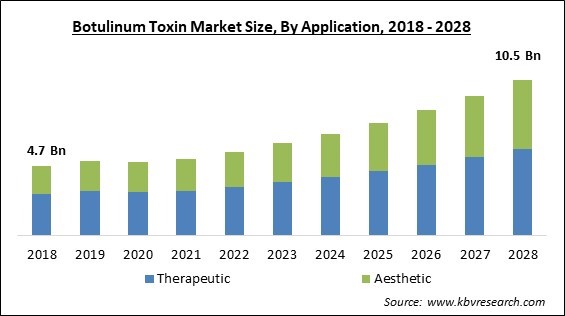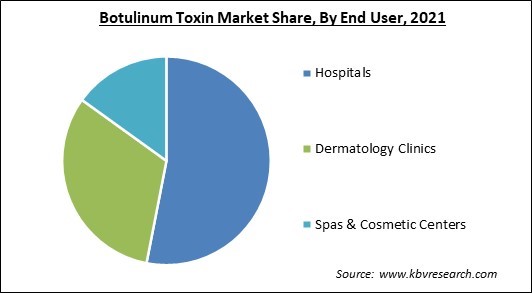
The Global Botulinum Toxin Market size is expected to reach $10.5 billion by 2028, rising at a market growth of 10.8% CAGR during the forecast period.
Botulinum toxin is a neurotoxin, which is one of the most lethal biological chemicals created by the bacterium Clostridium botulinum. Eight exotoxins with distinct antigens are produced by botulinum C. The main neurotransmitter at the neuromuscular junction, acetylcholine, is blocked by all serotypes, interfering with neuronal transmission and paralyzing muscles. Botulinum toxin A injection-induced weakness often lasts for three months.

Strabismus, focal dystonia, hemifacial spasm, various spastic movement disorders, hyperhidrosis, headaches, hypersalivation, and some chronic conditions that only partially respond to medical treatment are just a few of the many medical conditions that can now be controlled with the help of botulinum toxins. The number of potential new symptoms is growing quickly. Cosmetologically applications as well as dermatological ones, like hyperhidrosis to correcting lines, creases, and wrinkles all over the face, neck, chin, and chest are benefitted with this compound.
Botulinum toxin injections are often well tolerated and have very few adverse effects. To effectively use botulinum toxins in clinical practice, one must possess a thorough understanding and expertise of the functional anatomy of the mimetic muscles. Botulinum toxin, one of the most toxic biological molecules, is also known as miracle poison. This neurotoxin is produced by the anaerobic, gram-positive rod-shaped bacterium Clostridium botulinum, which is typically found on plants, in soil, water, and animal intestinal tracts.
Botulinum toxin type A can effectively treat strabismus in humans. Botulinum toxin was subsequently authorized for the treatment of several spasticity problems as well as a variety of other ailments. It is currently utilized in practically all medical subspecialties. The FDA authorized the cosmetic use of Botox (Botulinum toxin-A) in 2002 to temporarily lessen glabellar forehead frown lines.
The demand-supply equilibrium across the whole healthcare sector was severely disrupted by the pandemic. The botulinum toxin market has been considerably impacted due to this abrupt burden on the worldwide healthcare infrastructure. Many cosmetic treatments and operations were initially put on hold as a result of domestic as well as international lockdowns that were imposed in the majority of countries. However, due to the higher demand during the pandemic, sales of botulinum toxins, like Botox, witnessed a spike. Many dermatologists and plastic surgeons attribute the growth to people with the desire to look their best for conferences and online meetings, as well as having more time to attend consultations and recover from treatments.
Botulinum toxin is considered to be primarily utilized to treat cosmetic diseases, however, its medicinal uses go far beyond this. Botulinum toxin is a successful alternative to conventional therapy for patients with chronic migraine, muscle spasms, reagent bladder, and hyperhidrosis. Additionally, it has been found that botulinum toxin is quite effective at reducing chronic pelvic discomfort in females with endometriosis. People who have undergone botulinum toxin therapy are able to maintain their mobility for as long as 11 months.
botulinum toxin is utilized to treat a variety of aging-related problems, including crow's feet, glabellar lines, forehead lines, and others. People over 40 are therefore more likely to experience these indicators of aging. Therefore, botulinum toxin operations are becoming increasingly popular among people between the ages of 40 and 54. Among the most common non-invasive rejuvenation techniques, injectable botulinum toxin, soft-tissue fillers, as well as chemical peels each have particular uses for enhancing facial appearances.
Although botulinum toxin is typically regarded as safe when used in a clinical environment, it has the potential to have major negative effects. Botulinum toxin can most frequently be injected into the incorrect muscle group or over time can travel from the injection site, temporarily paralyzing undesired muscles. Unintentional paralysis of face muscles is the main cause of the side effects of cosmetic use. These include difficulty eating, muscle weakness, and partial facial paralysis.
On the basis of Product, the Botulinum Toxin Market is bifurcated into Type A and Type B. In 2021, the Type-A segment witnessed the biggest revenue share of the botulinum toxin market. The increase in the growth of the market is attributed to the rise in the number of cases of sialorrhea all over the world. There are a number of commercially available botulinum toxin type-A medications, including Botox and Dysport, that have undergone clinical testing and have been shown to be both safe and effective over the long term with the fewest side effects.

Based on Application, the Botulinum Toxin Market is divided into Therapeutic and Aesthetic. In 2021, the aesthetics segment recorded a significant revenue share of the botulinum toxin market. Botulinum toxin is a staple of the cosmetology toolbox. There have been more cosmetic procedures performed as a result of increased aesthetic consciousness and technology breakthroughs in both developed and developing nations.
By End-User, the Botulinum Toxin Market is segregated into Hospitals, Dermatology Clinics, and Spas & Cosmetic Centers. In 2021, the spas and cosmetic centers segment recorded a substantial revenue share of the botulinum toxin market. The segment's growth is primarily attributed to a higher inclination for aesthetic operations in dermatological clinics, spas, and cosmetic centers.
| Report Attribute | Details |
|---|---|
| Market size value in 2021 | USD 5.2 Billion |
| Market size forecast in 2028 | USD 10.5 Billion |
| Base Year | 2021 |
| Historical Period | 2018 to 2020 |
| Forecast Period | 2022 to 2028 |
| Revenue Growth Rate | CAGR of 10.8% from 2022 to 2028 |
| Number of Pages | 162 |
| Number of Tables | 327 |
| Report coverage | Market Trends, Revenue Estimation and Forecast, Segmentation Analysis, Regional and Country Breakdown, Companies Strategic Developments, Company Profiling |
| Segments covered | Product, Application, End User, Region |
| Country scope | US, Canada, Mexico, Germany, UK, France, Russia, Spain, Italy, China, Japan, India, South Korea, Singapore, Malaysia, Brazil, Argentina, UAE, Saudi Arabia, South Africa, Nigeria |
| Growth Drivers |
|
| Restraints |
|
Region-Wise, the Botulinum Toxin Market is analyzed across North America, Europe, Asia-Pacific, and LAMEA. In 2021, North America dominated the botulinum toxin market with the largest revenue share. The growth of regional market is expanding due to rising disposable income as well as an increase in cosmetic operations. Moreover, there is a significant number of market players operating in the region, who are increasing their focus and efforts in order to fulfill the rising demands of customers.
Free Valuable Insights: Global Botulinum Toxin Market size to reach USD 10.5 Billion by 2028
The market research report covers the analysis of key stake holders of the market. Key companies profiled in the report include Evolus, Inc. (Alphaeon Corporation), Merz Pharma GmbH & Co. KGaA, AbbVie, Inc., Ipsen Pharma, Galderma S.A., USWM, LLC, and Metabiologics, Inc. (Object Pharma).
By Product
By Application
By End User
By Geography
The Botulinum Toxin Market size is projected to reach USD 10.5 billion by 2028.
High Levels Of Effectiveness And Efficiency In Therapeutic And Cosmetic Applications are driving the market in coming years, however, Side Effects Related To The Use Of This Substance restraints the growth of the market.
Evolus, Inc. (Alphaeon Corporation), Merz Pharma GmbH & Co. KGaA, AbbVie, Inc., Ipsen Pharma, Galderma S.A., USWM, LLC, and Metabiologics, Inc. (Object Pharma).
The expected CAGR of the Botulinum Toxin Market is 10.8% from 2022 to 2028.
The Therapeutic segment acquired maximum revenue share in the Global Botulinum Toxin Market by Application in 2021 thereby, achieving a market value of $5.9 billion by 2028.
The North America market dominated the Global Botulinum Toxin Market by Region in 2021, and would continue to be a dominant market till 2028; thereby, achieving a market value of $3.8 billion by 2028.
Our team of dedicated experts can provide you with attractive expansion opportunities for your business.
